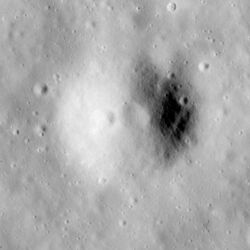Astronomy:Palmetto (crater)
 Apollo 16 image | |
| Diameter | 760 m[1] |
|---|---|

Palmetto crater is a small crater in the Descartes Highlands of the Moon visited by the astronauts of Apollo 16. The name of the crater was formally adopted by the IAU in 1973.[1]
On April 21, 1972, the Apollo 16 Lunar Module (LM) Orion landed about 1.5 km south of Palmetto, which is between the prominent North Ray and South Ray craters. The astronauts John Young and Charles Duke explored the area over the course of three EVAs using a Lunar Roving Vehicle, or rover. They drove along the rim of Palmetto on EVA 3, on their way to North Ray, but did not stop. As they drove by, Duke said "There's a good ejecta blanket of half-meter-size boulders around the rim of Palmetto into some of these secondary craters here."[2] On the way back to the lunar module from North Ray, Duke took a sequence of photos of Palmetto while riding on the rover.

The crater was also used as a landmark by Apollo astronauts on previous missions. It was designated landmark DE-1/12,[3] and astronaut Dick Gordon tracked it photographically on revolutions 42 and 44 of the Apollo 12 mission.
Palmetto crater is approximately 760 m in diameter and approximately 130 m deep.[4] The similar-sized crater Gator lies 1 km to the southeast.
Palmetto cuts into the Cayley Formation of Imbrian age.[5]
External links
- Apollo 16 Traverses, NASA Lunar Photomap 78D2S2(25)
References
- ↑ 1.0 1.1 Palmetto, Gazetteer of Planetary Nomenclature, International Astronomical Union (IAU) Working Group for Planetary System Nomenclature (WGPSN)
- ↑ Traverse to North Ray Crater, Apollo 16 Lunar Surface Journal.
- ↑ Lunar Landmark Locations - Apollo 8, 10, 11, and 12 Missions. NASA technical note D-6082. Manned Spacecraft Center, Houston, Texas. November 1970. Figure 22.
- ↑ Apollo 16 Landing Area, 78D2S1(50), NASA Lunar Topophotomap. Published by The Defense Mapping Agency, November 1974. Available from Lunar and Planetary Institute.
- ↑ Geologic Map of the Apollo 16 (Descartes) Landing Area by Apollo Field Geology Investigation Team (D. P. Elston, E. L. Boudette, J. P. Schafer), United States Geological Survey, April 1972
 |

